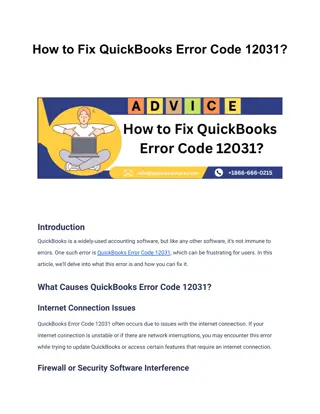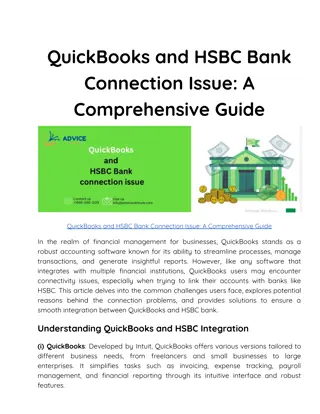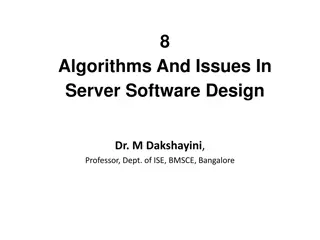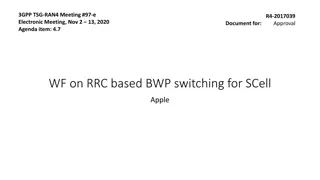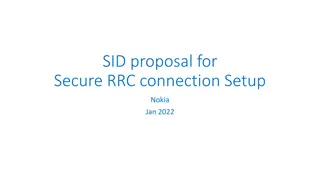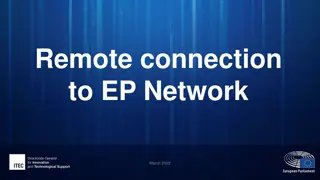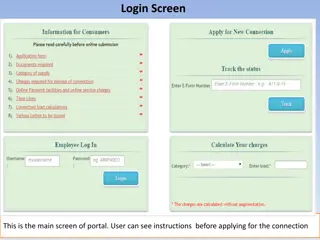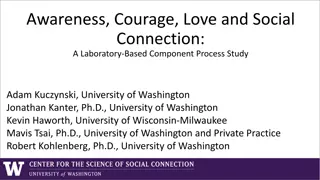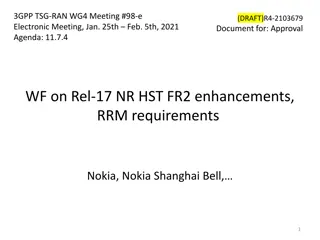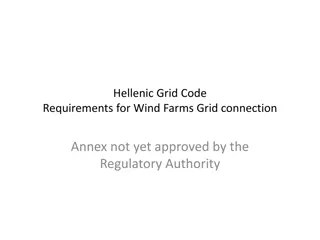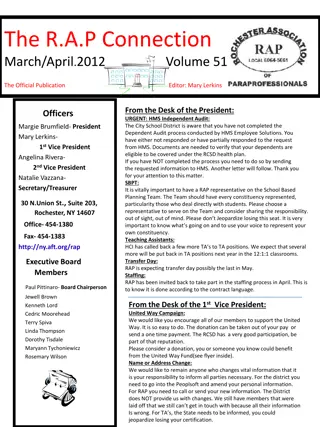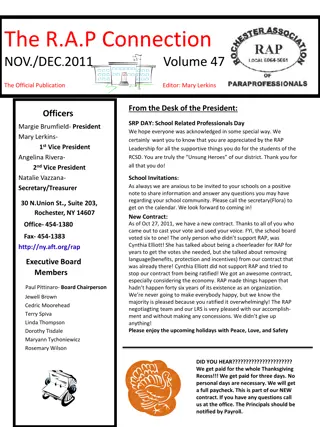
LTE Connection Protocols Overview
"Explore the architecture and protocols of LTE network connections, including RRC procedures, control planes, user planes, and physical layers. Learn about RRC connection establishment, NAS layer, and quality of service in LTE-Uu technology."
Download Presentation

Please find below an Image/Link to download the presentation.
The content on the website is provided AS IS for your information and personal use only. It may not be sold, licensed, or shared on other websites without obtaining consent from the author. If you encounter any issues during the download, it is possible that the publisher has removed the file from their server.
You are allowed to download the files provided on this website for personal or commercial use, subject to the condition that they are used lawfully. All files are the property of their respective owners.
The content on the website is provided AS IS for your information and personal use only. It may not be sold, licensed, or shared on other websites without obtaining consent from the author.
E N D
Presentation Transcript
LTE/SAE 3GPP Access Abbreviation List UE: User Equipment MME: Mobility Management Entity S-GW: Serving Gateway P-GW: Packet Data Network Gateway ePDG: Evolved Packet Data Gateway HSS: Home Subscriber Server AP: Access Point PCRF: Policy and Charging Rules Function ANDSF: Access network discovery and selection function EPC in SAE E-UTRAN eNodeB HSS MME PCRF ANDSF UE P-GW S-GW ePDG Internet WiFi AP Non-3GPP Access 2
LTE/SAE Control Plane User Plane Control Plane UE eNB MME User Plane UE eNB S-GW P-GW 3
LTE-Uu UE MME eNB NAS NAS Layer 3 RRC RRC PDCP PDCP RLC RLC Layer 2 MAC MAC PHY PHY Layer 1 4
LTE-Uu Layer 3 Layer 3 Non-Access Stratum (NAS) Bearers Radio Resource Control (RRC) RRC 5
LTE-Uu Layer 2 Layer 2 Packet Data Convergence Protocol (PDCP ) Radio Link Control (RLC) ARQ HARQ Medium Access Control (MAC) QoS (Quality of Service) 6
LTE-Uu Layer 1 Layer 1 Physical (PHY) OFDMA MIMO 7
RRC Connection Procedures RRC RRC_IDLE RRC_CONNECTED IDLE UE UE RRC_CONNECTED RRC RRC Connection Establishment RRC Initial Security Activation RRC Connection Reconfiguration RRC Connection Release 8
RRC Connection Procedures RRC Connection Establishment UE E-UTRAN RRCConnectionRequest RRCConnectionSetup RRCConnectionSetupComplete RRC RRC RRC_IDLE RRC_CONNECTED
RRC Connection Procedures RRC Connection Establishment (Cont.) UE E-UTRAN RRCConnectionRequest RRCConnectionReject RRC RRC RRC_IDLE 10
RRC Connection Procedures RRC Initial Security Activation UE E-UTRAN SecurityModeCommand SecurityModeComplete UE eNB 11
RRC Connection Procedures RRC Connection Reconfiguration UE E-UTRAN RRCConnectionReconfiguration RRCConnection- ReconfigurationComplete Handover 12
RRC Connection Procedures RRC Connection Release UE E-UTRAN RRCConnectionRelease RRC RRC_CONNECTED RRC_IDLE 13
RRC connection establishment eNB assigns the context: Radio resource configuration (Dedicated) SRB add/mod list: only SRB1 MAC main configuration Physical configuration UE EUTRAN UE EUTRAN RRCConnectionRequest (SRB0) RRCConnectionRequest (SRB0) RRCConnectionSetup (SRB0) RRCConnectionReject (SRB0) (+ NAS message) (network reject) RRCConnectionSetupComplete (SRB1) (successful)
Radio resource configuration: SRB (Signaling Radio Bearer) RLC TM mode SRB type Control Plane signalling Message contents Priority SRB0 CCCH Non-UE specific Highest SRB1 DCCH RRC + NAS High SRB2 DCCH NAS Low SRB2 are configured by E-UTRAN after security activation NAS messaging on SRB1 only occurs if SRB2 has not yet been established Operation: add/modify SRB1/2 context SRB ID Logical Channel Config RLC Config RLC AM mode
Attach procedure UE MME eNB RRCConnectionSetupComplte (Attach Request) Initial UE Message (Attach Request) Authentication and key Agreement (AKA), NAS SMC InitialContextSetupRequest (Attach Accept, Activate Default ESP Bearer) UE Capability Info Indication UECapabilityEnquiry UECapabilityInformation SecurityModeCommand SecurityModeComplete RRCConnectionReconfiguration (Attach Accept, Activate Default ESP Bearer) RRCConnectionReconfiguration Complete UL Information Transfer InitialContextSetupResponse UL NAS Transport (Attach Complete, Activate EPS Bearer context accept) Direct transfer NAS message (Attach Complete, Activate EPS Bearer context accept)
Functional Split between E-UTRAN & EPC eNB MME / S-GW MME / S-GW Inter Cell RRM RRM RB Control EPC S1 S1 Connection Mobility Cont. MME S1 S1 Radio Admission Control NAS Security X2 E-UTRAN eNB Measurement Configuration & Provision eNB eNB Idle State Mobility Handling X2 X2 Dynamic Resource Allocation (Scheduler) EPS Bearer Control eNB RRC PDCP S-GW P-GW RLC Mobility Anchoring UE IP address allocation MAC S1 PHY Packet Filtering internet E-UTRAN EPC RRM : Radio Resource Management RRC : Radio Resource Control TS 36.300
Whats RRM Definition: to allocate and manage the limited radio resource to maximize the system performance and capacity. Goal: ensure planned QoS of traffic ensure cell coverage ensure spectrum utilization Link Quality Optimization and tailoring Cell Coverage Cell Capacity
LTE features (1/6) RAN structure Most of RRM functions are located in eNB due to lack of the RRM server (a node to do multi-cell RRM) in E-UTRAN. MME / S-GW MME / S-GW MME / S-GW S1 S1 S1 S1 S1 S1 S1 S5 S1 S1 HeNB GW X2 E-UTRAN eNB eNB S1 S1 X2 X2 eNB X2 X2 HeNB HeNB HeNB
LTE features (2/6) System bandwidth allocation E-UTRAN supports 1.4/3/5/10/20 MHz bandwidths, while UTRAN FDD supports only 5MHz bandwidth. RRM is concerned that different bandwidths lead to different available resources and performance in frequency-selective scheduling.
LTE features (3/6) Multiple access techniques CDMA in UTRAN: both intra-cell and inter-cell UEs may generate interference. OFDMA/SC-FDMA in downlink/uplink in E-UTRAN: only inter-cell interference.
LTE features (4/6) Multiple antenna techniques LTE supports many MIMO modes and can dynamical switching among them. Physical resources in space dimension are different in the MIMO modes.
LTE features (5/6) Optimization of PS domain No CS domain in LTE. All traffic in PS domain are packets (i.e., variable length, bursty) and are defined by different parameters compared to CS domain. The parameters of each traffic are determined by many RRM processes.
QoS Class Identifier (QCI) QCI Resource Type Priority Packet Delay Budget Packet Error Loss Rate Example Services 10-2 2 100 ms 1 Conversational Voice 10-3 150 ms 2 4 Conversational Voice (Live Streaming) GBR 10-3 50 ms 3 3 Real Time Gaming 10-6 300 ms 4 5 Non-Conversational Video (Buffered Streaming) 10-6 100 ms 5 1 IMS Signalling Video (Buffered Streaming), TCP-based (e.g., www, e-mail, chat, ftp, p2p file sharing, progressive video, etc.) 10-6 300 ms 6 6 Non-GBR 10-3 100 ms 7 7 Voice, Video (Live Streaming), Interactive Gaming 8 8 Video (Buffered Sreaming), TCP-based (e.g., www, e-mail, chat, ftp, p2p file sharing, progressive video, etc.) 10-6 300 ms 9 9
LTE features (6/6) Share channel No dedicated channel in LTE. All traffic share the physical resources which are allocated by packet scheduler. Specifically, eNB tells the UE the transmission resources (via control signaling) and takes back them when transmission completed. Packet scheduler in UMTS is constrained by the dedicated channel design.
LTE Interface for RRM MME S1 S1AP X2AP OAM/ SON RRM eNB X2 RRC eNB

![READ [PDF] Sliding into Home (The Decker Connection)](/thumb/42245/read-pdf-sliding-into-home-the-decker-connection.jpg)

